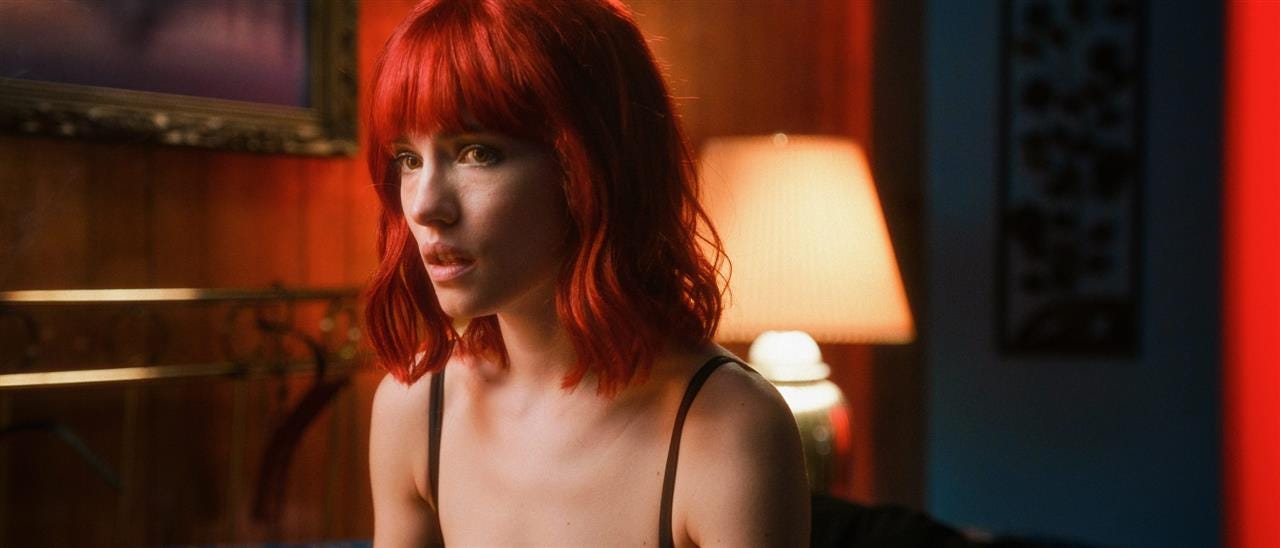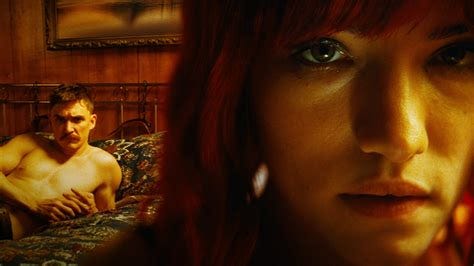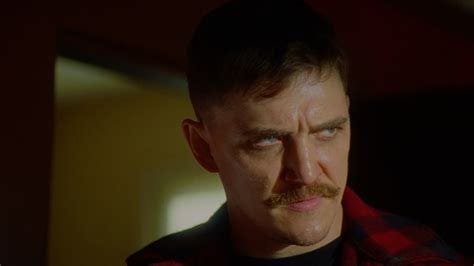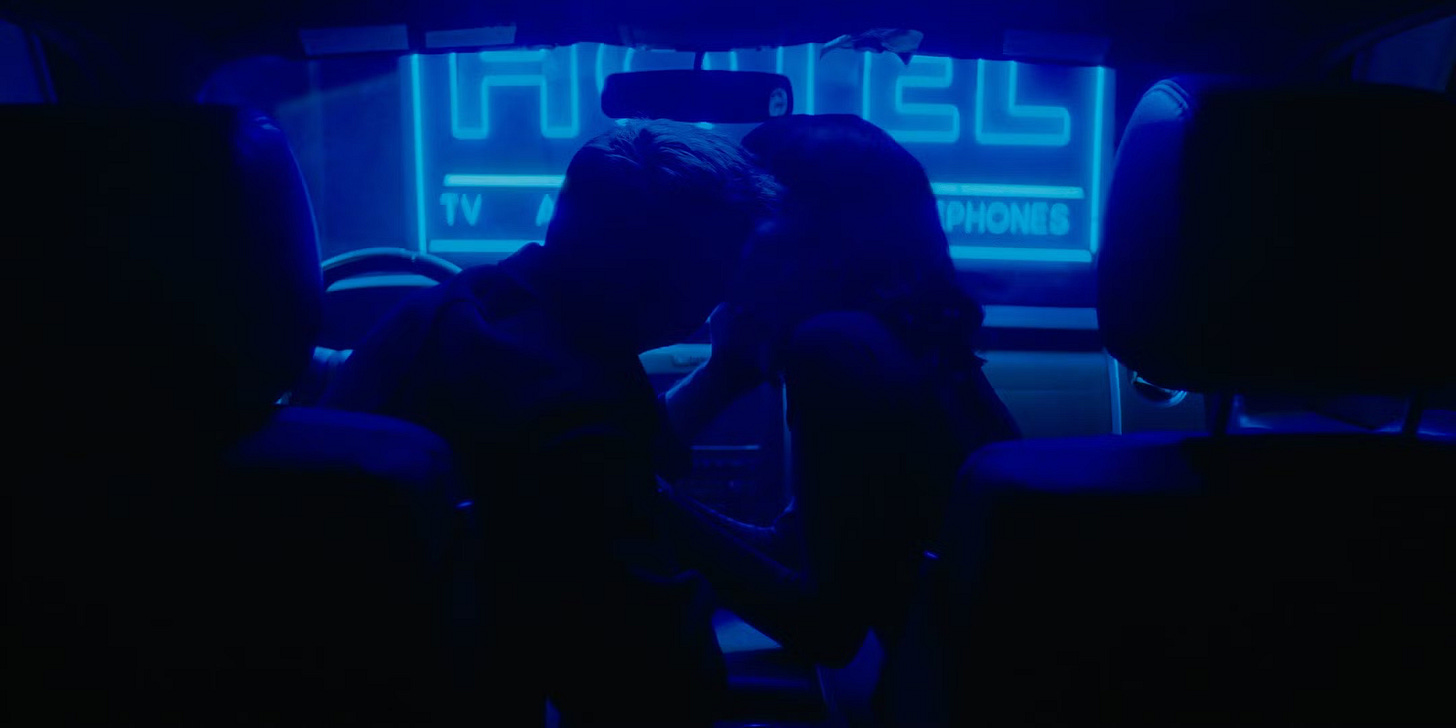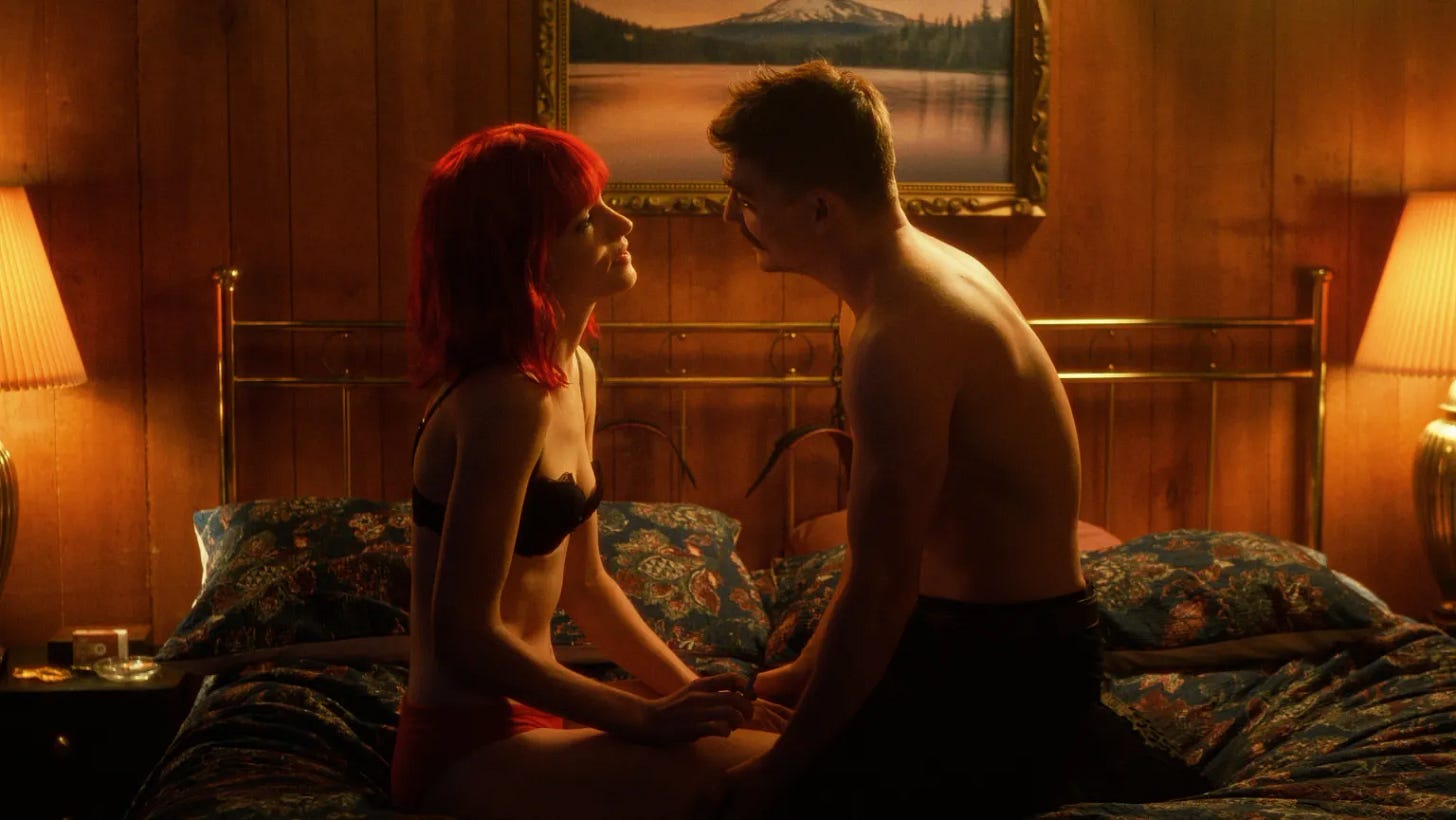STRANGE DARLING's America
PRELUDE
This essay is in the chapter order of Strange Darling.
Playing (clearly chapter-headed) events out of order upends expectations and forces examination of preconceived notions.
CHAPTER THREE: CONSTRUCTION
Another very unTarantino vibe is how spare the dialogue is. "Ya know, her groceries are on one shelf of the refrigerator, mine are on the other" is the only thing we hear about the Demon’s wife. It suggests he already discussed his marital quote-unquote 'separation' from his wife with Willa Fitzgerald's character before the film and he move on, because it's not the point.
Along with sparseness is familiarity; Strange Darling sets you up to think "Oooooh, I know this one” then instead of subverting the thing it does the thing and pulls it off. The film assembles nearly all tropes and playthings horror films love: a deus-ex-bear-mace; revealing a character’s Actual Job quite later than you’d expect; someone running away in their underwear while happening to have on sturdy boots; etc. The structure allows the script to then go back and show exactly how those pieces came to be arranged – just like with the Scott Baio puzzle.
Speaking of Scott Baio, it makes sense for a middle-aged couple to assemble a puzzle of an American actor who starred in three of the most famous TV shows of the 70s, 80s, AND 90s . . . but everyone knows you start puzzles with edge pieces. Them having a somewhat-complete puzzle without the edges finished feels like meta-commentary on Strange Darling’s structure.
Movies, like puzzles, aren’t just about the design and the process but the assembly: near all the above events are seen in the first 15 minutes, then explained in the following 80. The reveals build on everything we know, while explaining the logic of why details were withheld (until they weren't). The narrative takes care to explain not only those conveniences, but little things like ‘how people justify cheating and murder while still believing and proclaiming they are good people.’
Giovanni Ribisi wields the camera to support this thesis, using a detached observational style, constantly reminding us you are an audience. In one scene the camera follows Kyle Gallner's character through a house, sometimes stopping or letting him leave frame. This calls attention to filmmaking as a construct, reminding us it’s assembling these tropes, the characters aren’t real people but Types, and we should analyse and internalise accordingly.
And boy does that matter in The Discourse of the film.
CHAPTER FIVE: ICONOGRAPHY
A non-exhaustive list of Strange Darling’s icons and symbols:
American flag
Red, White, and Blue (the main colour-washes are red and blue, with bookend sequences in black and white)
leather biker jacket
red hunting jacket
Doc Martens (the US loves to co-opt a British artifact!)
black lingerie
firearms, from pistols to shotguns
cigarettes and lighters
the WAY they smoke cigarettes, like a noir character or someone who is aware they’re in Rebel Without a Cause
the soundtrack including "Love Hurts" and folk croons
immoderate pancake breakfast
a Native American in a cowboy hat (we will absolutely circle back to this)
multiple types of cops and their badges
several classic vehicles, from a cop car to a chevy truck
Acknowledging something is sexy and alluring doesn’t endorse or condone its every use or narrative.
CHAPTER ONE: INTRODUCTION
Strange Darling operates within a world of Grindhouse Americana, chopping and changing the narrative pieces and genre (thus societal) implications without fear of the audience’s opinion.
It’s actually pretty distinctly American to not give a fuck in the ways Strange Darling doesn’t.
It understands misogyny doesn’t preclude the existence of evil women. It understands irony and how playing within rules doesn’t make one less-evil or even ‘good’ in the technical sense — for example it takes particular care to show Gallner's character use gun safety. As the film goes plays as its own dark humour around not only his character but American gun culture in general: a stalking, murderous character happy to pump someone’s chest full of lead is quote unquote 'safe' around a gun.
And there are a lot of guns — as symbols, as weapons, as levers of power, and as instruments of gory death — throughout.
CHAPTER FOUR: WHO IS THIS EMBOLDENING?
One complaint I’ve seen repeated is "this film gives ammunition to the whiny boys who think all women are lying, manipulative creatures." This criticism has been levelled at (among other films) Gone Girl and The Matrix, neither of which are directly referenced – Strange Darling isn’t that kind of meta – but which the film is clearly aware of within the culture it depicts.
First: whiny unintelligent fuckwits don't need ammo, let alone arthouse and/or indie film ammo, to spout their daily gripes.
Second: this movie is specifically interested in those gripes, how gendered assumptions and gender roles and manipulation play out in America. It specifically addresses the (no other word covers it) intersectionality of the questions, not using the gender and race and appearance of the killer for shock value but to address why and those things can be so leveraged, how they coalesce a certain way in America and specifically the Pacific NorthWest.
Strange Darling’s deep interest are displayed not only in plot and story and acting and casting, but in its prolific iconography.
CHAPTER TWO: STRUCTURE AND FAMILIARITY
Almost the entire trailer comes fromthe ‘climactic sequences’ section which just so happens to be the first 20 minutes. This works particularly well for low-budget films which really need to leverage their impressive / expensive setpieces, but also displays the kind of trust this whole piece is interested in: a narrative push-pull which can’t care whether it offends and disturbs.
The chapter order may create fear of gimmick, but the risk immediately enables other benefits, especially from acting and meta-storytelling perspectives. The film expects the audience to be familiar with (or at least innately understand) Western cinematic language — then instead of using that language to cheat or attempt to fool us, it has fun knowing we're keeping up as we guess along with its developments.
All of which is to say every chapter comes in hot and fast, rides full-tilt to the "too far" line, then gets out quick and hard.
Just don't call it Tarantino-esque, because despite his explicitly American grindhouse and gore-heavy films, Strange Darling’s numbered headings explicitly uses different tools than his scripts do.
CHAPTER SIX: IN CONCLUSION
Strange Darling critiques America’s autobiographical narrative: how tears and looks are leveraged; from whom narrative, tears, and violence are taken most seriously; the type of sociopathy we engender; and the people and society the combination of all that produces.
The tiny, almost-cameo-sized appearance of two cops late in the piece isn't to 'make fun' of the lady cop but to critique cops and gullibility, as well as how the US has created two wildly different subcultures who can operate with impunity. The two subcultures of cops and white-power-fragility are built to protect and uphold each other, even if – or rather, until – it kills them.
The movie knows exactly why those cops, like everyone else in the story, takes the hot, sad white woman's story at face value . . . Everyone, that is, until the epilogue.
As that classic baby blue truck pulls up, the audience is primed to think"Oh noooo, don’t keep going, but also don't have Her get in and then cut to black, to cheat and allow the audience the assumption that She keeps going . . .”
Instead of either, the Cherokee woman (Sheri Foster) in a cowboy hat is the only person who doesn't get sucked in by the Great American Facade.
Our cowboy in her trusty steed offers to help but is highly wary, and when The Electric Lady pulls on her the cowboy shoots in self defence without hesitation . . . . . . . . . . . . . . . then the film places the bookend with a long shot that Fitzgerald plays perfectly as colours change in a reversal of one of the opening shots.
EPILOGUE
Thing is, movies aren't a fucking contest. It doesn’t matter to enjoyment or enrichment whether you ‘get it’ sooner than anyone else. Many scenes – for example a power struggle which reads as assault until it’s revealed as consensual sex game – cue the viewer to smugly think "I see through this" and the text replies “congrats, do you want a cookie?”
Strange Darling isn't trying to trick you, it's simply telling a story out-of-order. As more pieces are revealed, the response shouldn’t be “I win” or “ugh too understandable” but “what does this mean to me, what does it say about American culture, how can we change for the better?”
The premise of Grindhouse Americana if not designed to relieve viewers of their discomfort, whether in-film or extra-textual. In the midst of sensationalism which will turn away and lure in people from both ends of the spectrum, the unflinching critique of America is its most potent element.
Also, like, it's hella fun.




